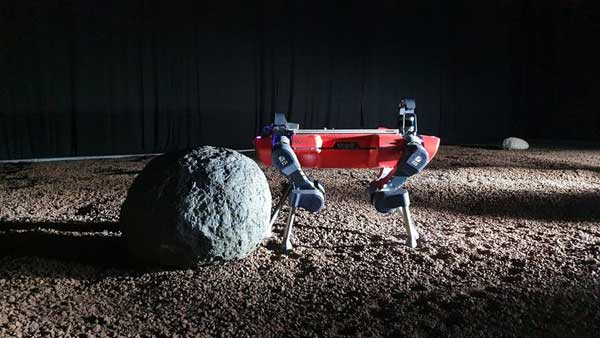
European Space Agency (ESA) & European Space Resources Innovation Centre (ESRIC) challenged European and Canadian engineering teams to develop vehicles capable of prospecting resources within a testbed of the Moon’s shadowy polar regions. Five winners are receiving development grants of 75 000€ each to move their rovers forward to the next phase of the contest, to be held in Luxembourg in September 2022.
BELVAUX, Luxembourg (ESRIC PR) — It is 2028. The European Large Logistic Lander just descended in the area between the Shoemaker and Faustini crater in the South Pole region of the Moon. The mission: to characterise and locate resources (water and metals..) and produce an accurate map of the little impact crater a few hundred meters from the lander, to make a first resource map to guide future missions… We’re not there yet, but this mission scenario is very close to what a future European mission could look like.
The Moon is the next step in human exploration, and prospecting – in other words detecting and locating – resources on the Moon is the first mandatory step toward collecting and using them in-situ to establish human habitats there.
THE FIRST EUROPEAN PROSPECTING CHALLENGE
Terrestrial prospecting technologies need to be adapted to the rigours of a dusty, vacuum environment and temperature extremes of the lunar surface. This is the reason why the European Space Resources Innovation Center (ESRIC) and the European Space Agency (ESA) challenged last summer, and for the first time, European and Canadian engineering teams from academia and industry to develop vehicles capable of prospecting resources known to lurk in these shadowy regions – then put their designs to the test in a realistic lunar analog environment.
The first part of the ESA-ESRIC Space Resources Challenge was organised in the Netherlands, next to the European Space Research and Technology Centre (ESTEC) facilities. Working inside a former aircraft hangar, the competition organisers spread 200 tons of lava rock across an area equivalent to seven tennis courts, landscaping it into a Moon-like environment, including the main crater of interest. Then they scattered rocks, including a hundred larger simulated boulders larger than a metre across, whose positions were precisely geo-referenced.
These measurements served as the basis of a map provided to the rover teams. The idea was to give them the equivalent level of local information from satellite imagery, while still leaving smaller-scale surprises. Once complete, the moonscape was kept concealed from the rover groups behind black curtains, so they would see it only through the cameras of their rovers. 13 teams made a prospecting attempt one at a time.
“Over a two and a half hour period, each rover had to find their its way across the moonscape to the target crater, then prospect for resources,” comments co-organiser Franziska Zaunig. “This was a challenging goal across unknown lunar terrain within the set time.”
The participating teams took various approaches in terms of locomotion – wheeled, tracked and also walking vehicles entered the competition – as well as visual and multi-spectral instrumentation, and in a few cases multiple instead of single rovers.
Massimo Sabbatini, overseeing the contest’s first phase for ESA adds: “Not everyone made it to the crater at all: some groups found they didn’t have sufficient lighting on their rovers, others suffered battery problems. A few had difficulties with the artificial signal delay we included, which simulates the actual experience of teleoperating to the Moon. But it’s fair to say that everyone learned a lot – including us.”
Further to this first phase, five winning teams have been selected, receiving €75 000 contracts each to move their rovers forward to the next phase of the contest.
The winning teams are:
• ETH Zurich & University of Zurich (Switzerland)
• Mission Control Space Services (Canada)
• Łukasiewicz – PIAP (Poland)
• FZI Forschungszentrum Informatik (Germany)
• Space Application Services & Universite Du Luxembourg & Dynamic Imaging Analytics & La Palma Research Centre & University de Lorraine & The Open University (Belgium/Luxembourg/UK/Spain/France)
TAKING THE MOON TO LUXEMBOURG
The second stage of the challenge will be hosted by ESRIC in Luxembourg from 7 to 9 September 2022.
A Lunar environment built with various resources – kept secret from the teams- will be set up in Esch Belval, in the Rockhal’s large hall. As during the first phase, each team will be able to explore the “moon” one after the other, and will be asked to map the resources of the whole area during a limited time and in conditions simulating the lunar environment in terms of lighting, surface and elevation.
ESRIC Strategic Advisor and project Manager Bob Lamboray states: “ESRIC is looking forward to welcoming these five winners from this phase to Luxembourg. Through the ESRIC prize, we will support the final winner to further mature their design and hopefully make it to the Moon in the near future.“
An event including demonstrations and rover presentations is foreseen right after the competition and will be open to the public. More information will follow before summer.
About ESRIC
Based in Luxembourg, the European Space Resources Innovation Centre (ESRIC) fosters innovation and growth in the space resources industry by connecting leading academic, industrial and entrepreneurial talents. ESRIC’s activities are based on four main pillars: space resources research and development, support for economic activities, knowledge management, and community management. Launched in November 2020, ESRIC is an initiative of the Luxembourg Space Agency (LSA) and the Luxembourg Institute of Science and Technology (LIST) in strategic partnership with the European Space Agency (ESA).

